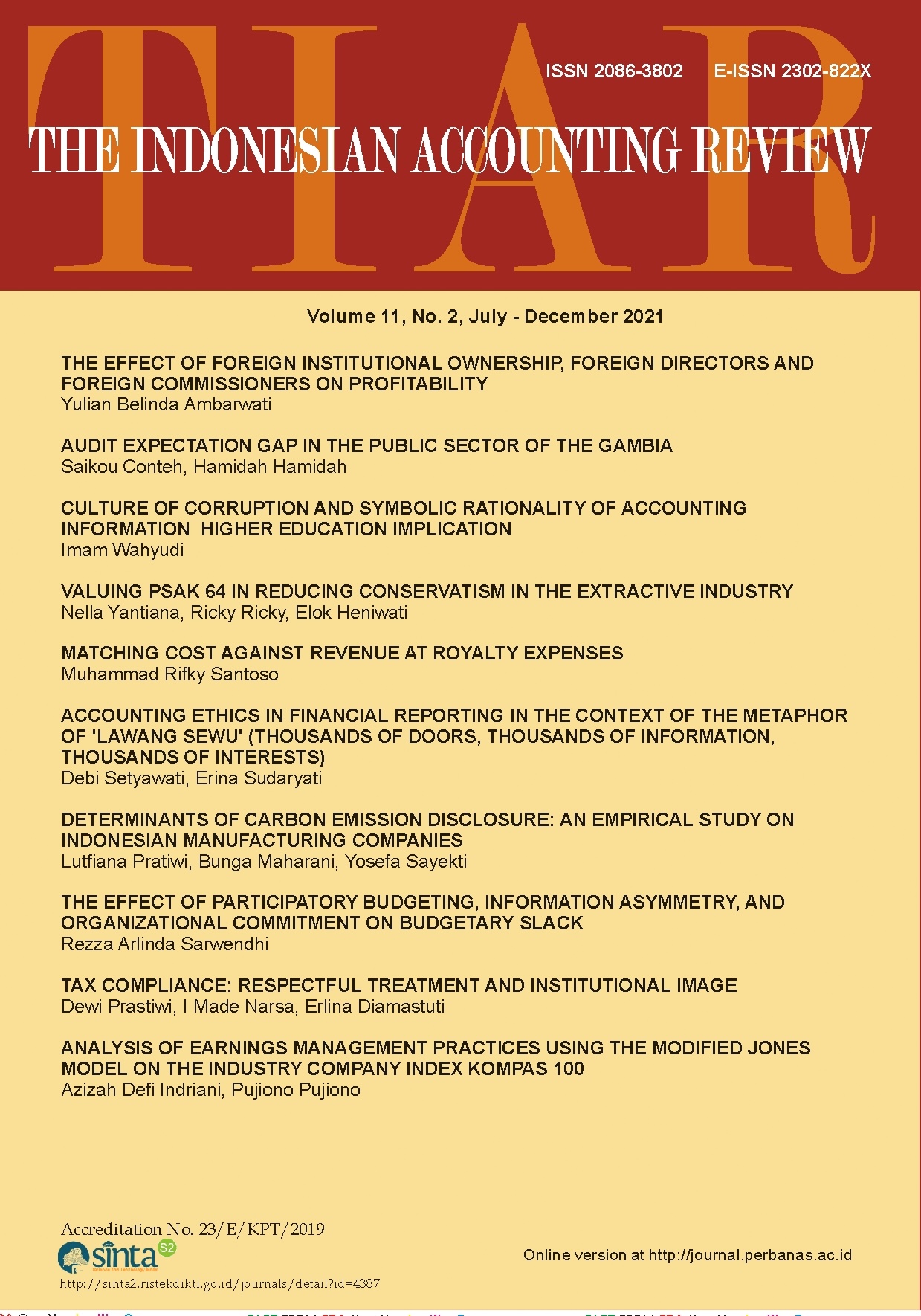Tax Compliance: Respectful Treatment and Institutional Image
DOI:
https://doi.org/10.14414/tiar.v11i2.2471Keywords:
tax compliance, respectful treatment, institutional image.Abstract
This study aims to analyze the effect of respectful treatment and institutional image on tax compliance. This study used a survey method of individual non-employee taxpayers at the Primary Tax Office (KPP) in the Regional Office of the DJP I, East Java, totaling 304 respondents. The data were analyzed using Structural Equation Modeling (SEM). The research findings showed that the strength of Crowding Theory and Trust Theory, and that the extrinsic intervention in the form of reward and punishment cannot always increase taxpayer compliance. Instead, a respectful approach and goodwill, ability and integrity of tax authorities in solving tax problems of taxpayers can increase tax compliance. This is supported by the results of the study that: 1) respectful treatment can improve institutional image; 2) respectful treatment can increase tax compliance; 3) institutional image can increase tax compliance. The implication of research results, respectful treatment of tax officers can be used to improve the image of the DJP and taxpayer compliance.
References
Alabede, J. O. (2011). Determinants of Tax Compliance Behaviour : A Proposed Model for Nigeria. International Research Journal of Finance and Economics, 78(78).
Alm, J., Cherry, T., Jones, M., & Mckee, M. (2010). Taxpayer information assistance services and tax compliance behaviour. Journal of Economic Psychology, 31, 577–586. https://doi.org/10.1016/j.joep.2010.03.018
Alm, J., Jackson, B. R., & McKee, M. (2009). Getting the word out: Enforcement information dissemination and compliance behaviour. Journal of Public Economics, 93(3–4), 392–402. https://doi.org/10.1016/j.jpubeco.2008.10.007
Alm, J., Jackson, B. R., Mckee, M., & Jackson, B. R. (1992). Estimating The Determinants Of Taxpayer Compliance With Experimental Data. National Tax Association, 45(1), 107–114. Retrieved from http://www.jstor.org/stable/41788949
Alm, J., & Torgler, B. (2011). Do Ethics Matter? Tax Compliance and Morality. Journal of Business Ethics, 101(4), 635–651. https://doi.org/10.1007/s10551-011-0761-9
Anne, L. J., & Hartel Charmine E.J. (2012). Improving tax compliance strategies: Can the theory of planned behaviour predict business compliance? E-Journal Tax Research, 10(2).
Battiston, P., & Gamba, S. (2016). The impact of social pressure on tax compliance: A field experiment. International Review of Law and Economics, 46, 78–85. https://doi.org/10.1016/j.irle.2016.03.001
Becker, G. (1968). Crime and Punishment: An Economic Approach. Journal of Political Economy, 76(2), 169–217. Retrieved from http://www.nber.org/books/beck74-1
Blumenthal, M., Christian, C., Slemrod, J., & Smith, M. G. (2001). Do Normative Appeals Affect Tax Compliance? Evidence from a Controlled Experiment in Minnesota. National Tax Journal, 54(1), 125–138. https://doi.org/10.17310/ntj.2001.1.06
Bobek, D. D., & Hatfield, R. C. (2003). An Investigation of the Theory of Planned Behavior and the Role of Moral Obligation in Tax Compliance. Behavioral Research in Accounting, 15(1), 13–38. https://doi.org/10.2308/bria.2003.15.1.13
Carter, J., Ph, D., & Heath, S. B. (2011). Motivational Interactions : effects on behaviour. Annales D’Economie Et De Statistique, (63).
Castr, L., & Scartascini, C. (2015). Tax Compliance and Enforcement in the Pampas Evidence from a Field Experiment. Journal of Economic Behavior and Organization.https://doi.org/10.1016/j.jebo.2015.04.002
Castro, L., & Scartascini, C. (2015). Tax compliance and enforcement in the pampas evidence from a field experiment. Journal of Economic Behavior and Organization, 116, 65–82. https://doi.org/10.1016/j.jebo.2015.04.002
Chung, J., & Trivedi, V. U. (2003). The Effect of Friendly Persuasion and Gender on Tax Compliance Behavior. Journal of Business Ethics, 47(2), 133–145. https://doi.org/10.1023/A:1026004716676
Cullis, J. G., & Lewis, A. (1997). Why people pay taxes†From a conventional economic model to a model of social convention. ELSEVIER Journal of Economic Psychology, 18, 305–321. https://doi.org/10.1016/S0167-4870(97)00010-X
Direktorat Jendral Pajak. (2016). Laporan Kinerja Direktorat Jendral Pajak Tahun 2016.
Dulleck, U., Fooken, J., Newton, C., & Ristl, A. (2015). Tax Compliance and Psychic Costs: Behavioral Experimental Evidence Using a Physiological Marker. Journal of Public Economics. https://doi.org/10.1016/j.jpubeco.2015.12.007
Eichfelder, S., & Kegels, C. (2014). Compliance costs caused by agency action? Empirical evidence and implications for tax compliance. Journal of Economic Psychology, 40, 200–219. https://doi.org/10.1016/j.joep.2012.08.012
Epetimehin, F. M. (2011). The Impact of Relationship Marketing on the Performance of Insurance Organisation. Mediterranean Journal of Social Science, 2(2).
Feld, L. P., & Frey, B. S. (2002). The tax authority and the taxpayer: an exploratory analysis.
Feld, L. P., & Frey, B. S. (2007). Tax compliance as the result of a psychological tax contract: The role of incentives and responsive regulation. Law and Policy, 29(1), 102–120. https://doi.org/10.1111/j.1467-9930.2007.00248.x
Feld, L. P., & Larsen, C. (2012). Self-perceptions, government policies and tax compliance in Germany. International Tax and Public Finance, 19(1), 78–103. https://doi.org/10.1007/s10797-011-9196-6
Filippin, A., Fiorio, C. V., & Viviano, E. (2013). The Effect Of Tax Enforcement On Tax Morale. Temi di discussion series (Vol. 35). https://doi.org/10.1162/JEEA.2008.6.6.1109
Frey, B. S., & Feld, L. P. (2002). Deterrence and Morale in Taxation: An Empirical Analysis.
Gangl, K., Muehlbacher, S., de Groot, M., Goslinga, S., Hofmann, E., Kogler, C., … Kirchler, E. (2013). “How can I help you?†Perceived Service Orientation of Tax Authorities and Tax Compliance. Public Finance Analysis, 69(4), 487–510. https://doi.org/10.1628/001522113X675683
Gangl, K., Torgler, B., Kirchler, E., & Hofmann, E. (2014a). Effects of supervision on tax compliance : Evidence from a field experiment in Austria. Economics Letters, 123(3), 378–382. https://doi.org/10.1016/j.econlet.2014.03.027
Gangl, K., Torgler, B., Kirchler, E., & Hofmann, E. (2014b). Effects of supervision on tax compliance: Evidence from a field experiment in Austria. Economics Letters, 123(3), 37–382. https://doi.org/10.1016/j.econlet.2014.03.027
Giovanis, A. N., Zondiros, D., & Tomaras, P. (2014). The Antecedents of Customer Loyalty for Broadband Services: The Role of Service Quality, Emotional Satisfaction and Corporate Image. Procedia - Social and Behavioral Sciences, 148, 236–244. https://doi.org/10.1016/j.sbspro.2014.07.039
Gobena, L. B., & Van Dijke, M. (2016). Power, justice, and trust: A moderated mediation analysis of tax compliance among Ethiopian business owners. Journal of Economic Psychology, 52, 24–37. https://doi.org/10.1016/j.joep.2015.11.04
Hu, H.-H. (Sunny), Kandampully, J., & Juwaheer, T. D. (2009). Relationships and impacts of service quality, perceived value, customer satisfaction, and image: an empirical study. The Service Industries Journal, 29(2), 111–125. https://doi.org/10.1080/02642060802292932
Iva Nurdiana Nurfarida, E. D. (2016). Kepercayaan Sebagai Mediasi Hubungan Corporate Image Terhadap Loyalitas Pelanggan Mobil Low MPV. Jurnal Ekonomi Modernisasi, 12(3), 99–106.
Kasiri, L. A., Guan Cheng, K. T., Sambasivan, M., & Sidin, S. M. (2017). Integration of standardization and customization: Impact on service quality, customer satisfaction, and loyalty. Journal of Retailing and Consumer Services, 35(November 2016), 91–97. https://doi.org/10.1016/j.jretconser.2016.11.007
Kassim, N., & Asiah Abdullah, nor. (, 2010). The effect of perceived service quality dimensions on customer satisfaction, trust, and loyalty in e-commerce settings: A cross-cultural analysis. Asia Pacific Journal of Marketing and Logistics, 22(3), 351–371. https://doi.org/10.1108/13555851011062269
Kirchler, E., Hoelzl, E., & Wahl, I. (2008). Enforced versus voluntary tax compliance: The “slippery slope†framework. Journal of Economic Psychology, 29(2), 210–225. https://doi.org/10.1016/j.joep.2007.05.004
Kleven, H. J., Knudsen, M. B., Kreiner, C. T., Pedersen, S. S., & Saez, E. (2011). Unwilling or Unable to Cheat? Evidence From a Tax Audit Experiment in Denmark. Econometrica, 79(3), 651–692. https://doi.org/10.2307/41237767
Ladhari, R., Souiden, N., & Ladhari, I. (2011). Determinants of loyalty and recommendation: The role of perceived service quality, emotional satisfaction and image. Journal of Financial Services Marketing, 16(2), 111–124. https://doi.org/10.1057/fsm.2011.10
Lai, C.-C., Yang, C.-Y., & Chang, J.-J. (2003). Environmental regulations and social norms. International Tax and Public Finance, 10(1), 63–75. https://doi.org/10.1023/A:1022229029894
Liou, J. J. H., & Chuang, M. L. (2009). Evaluating corporate image and reputation using fuzzy MCDM approach in the airline market. Quality and Quantity, 44(6), 1079–1091. https://doi.org/10.1007/s11135-009-9259-2
LLisi, G. (2015). Tax morale, tax compliance and the optimal tax policy. Economic Analysis and Policy, 45, 27–32. https://doi.org/10.1016/j.eap.2014.12.004
Luttmer, E. F. P., & Singhal, M. (2017). Tax Morale. Journal of Economic Perspectives, 28(4), 149–168. Retrieved from http://www.jstor.org/stable/23973562
Mayer, R. C., Davis, J. H., & Schoorman, F. D. (1995). Model of Trust. Academy of Management, 20(3), 709–734. https://doi.org/10.5465/AMR.1995.9508080335
McKee, M., Siladke, C. A., & Vossler, C. A. (2018). Behavioural dynamics of tax compliance when taxpayer assistance services are available. International Tax and Public Finance, 25(3), 722–756. https://doi.org/10.1007/s10797-017-9466-z
Mohdali, R., Isa, K., & Yusoff, S. H. (2014). The Impact of the Threat of Punishment on Tax Compliance and Non-compliance Attitudes in Malaysia. Procedia - Social and Behavioral Sciences, 164(August), 291–297. https://doi.org/10.1016/j.sbspro.2014.11.079
Novianti, Agnes F., Uswati Dewi, Nurul H. (2017). An investigation of the Theory of Planned Behavior and the role of Tax Amnesty in tax compliance. The Indonesian Accounting Review Vol. 7, No. 1, 79-94.
Slemrod, J. (2002). Tax Avoidance, Evasion, and Administration. In Handbook of Public Economics (Vol. 3, pp. 1423–1470). Elsevier Science.
Vossler, C. A., & McKee, M. (2017). Efficient Tax Reporting: the Effects of Taxpayer Liability Information Services. Economic Inquiry, 55(2), 920–940. https://doi.org/10.1111/ecin.12425
Wahl, I., Kastlunger, B., & Kirchler, E. (2010a). Trust in Authorities and Power to Enforce Tax Compliance : An Empirical Analysis of the Slippery Slope Framework. Law and Policy, 383(4), 384–406. https://doi.org/10.1016/j.joep.2007.05.004
Wahl, I., Kastlunger, B., & Kirchler, E. (2010b). Trust in Authorities and Power to Enforce Tax Compliance : An Empirical Analysis of the Slippery Slope Framework. Law and Policy, 383(4), 384–406. https://doi.org/10.1016/j.joep.2007.05.004
Weiwei, T. (2007). Impact of Corporate Image and Corporate Reputation on Customer Loyalty: a Review. Management Science and Engineering, Vol.1 No. (2), 57–62. https://doi.org/http://dx.doi.org/10.3968/j.mse.1913035X20070102.008
Downloads
Submitted
Published
How to Cite
Issue
Section
License
Copyright (c) 2021 The Indonesian Accounting Review

This work is licensed under a Creative Commons Attribution-NonCommercial 4.0 International License.


















